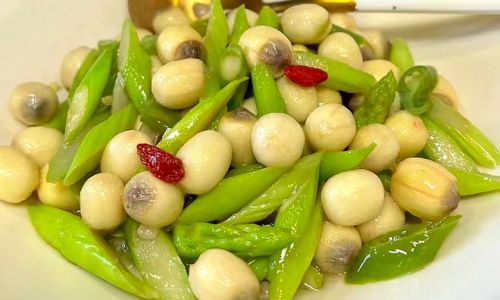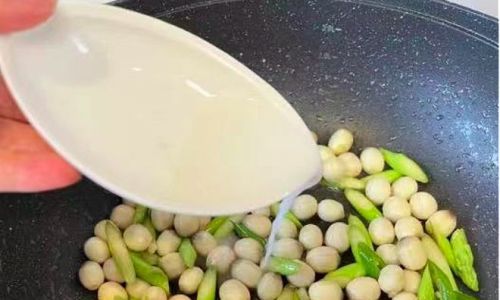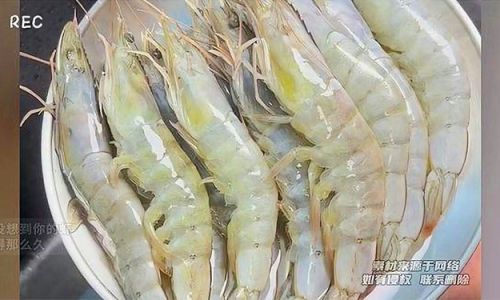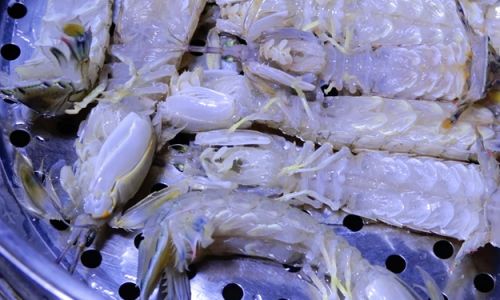Introduction

In the realm of Asian cuisine, lotus seeds are a treasure trove of nutrition and flavor, often overlooked but deeply cherished by those who know their worth. These tiny, pearl-like kernels, nestled within the lotus pod, boast a nutty, subtly sweet taste that pairs beautifully with a variety of ingredients. Fresh lotus seeds, in particular, offer a unique texture and freshness that dried seeds cannot replicate. Stir-frying fresh lotus seeds is a simple yet elegant way to bring out their natural sweetness and create a dish that is both visually appealing and palate-pleasing. This article will guide you through the process of how to stir-fry fresh lotus seeds for a delightful culinary experience, ensuring that every bite is a burst of flavor and texture.
Understanding Fresh Lotus Seeds
Before diving into the stir-frying process, it’s crucial to understand the basics of fresh lotus seeds. Fresh lotus seeds are typically harvested during the summer and early autumn when the lotus pods are mature but still tender. They have a light green hue and a slightly softer texture compared to their dried counterparts. Fresh lotus seeds are more perishable and should be used within a few days of harvesting for optimal freshness and flavor.
When selecting fresh lotus seeds, look for pods that are firm and have no signs of mold or rot. Once the pods are opened, the seeds should be plump, with a uniform color, and free from any discoloration or damage. Rinse the seeds thoroughly under cold running water to remove any dirt or residue before use.
Preparation Before Stir-Frying
-
Cleaning and Soaking:
Begin by carefully removing the seeds from their pods. Once separated, rinse them thoroughly in cold water to remove any remaining dirt or debris. Soaking the seeds in cold water for about 30 minutes can help soften them slightly, making them more tender during the stir-frying process. However, be cautious not to soak them for too long, as this can cause them to lose their firm texture. -
Blanching (Optional):
For an extra layer of flavor and texture control, you can blanch the seeds before stir-frying. Blanching involves immersing the seeds in boiling water for about 2-3 minutes and then plunging them into ice water to stop the cooking process. This step helps to remove any bitterness, brighten their color, and set their texture, ensuring they hold up well during stir-frying.
Stir-Frying Fresh Lotus Seeds
Now, let’s dive into the stir-frying process. The key to a successful stir-fry lies in high heat, quick cooking, and the right combination of ingredients to enhance the natural flavors of the lotus seeds.
-
Heating the Pan and Oil:
Start by heating a wok or large skillet over medium-high heat. Add a sufficient amount of oil—vegetable, peanut, or sesame oil works well—and allow it to become hot but not smoking. The right temperature is crucial for achieving a golden-brown crust on the seeds without burning them. -
Adding Aromatics:
Once the oil is hot, add a few aromatic ingredients to flavor the oil. Garlic slices, ginger strips, and shallots can all add layers of complexity to your dish. Stir-fry these aromatics for about 30 seconds until fragrant but not burnt. -
Stir-Frying the Seeds:
Drain the soaked or blanched lotus seeds well and add them to the hot wok. Stir constantly to prevent burning and ensure even cooking. The seeds should start to turn golden brown after about 2-3 minutes of stir-frying. If you prefer a crisper texture, you can cook them a little longer, but be mindful of not overcooking them, as they can become tough. -
Seasoning:
As soon as the seeds are evenly browned, add a pinch of salt to taste. You can also incorporate other seasonings like a dash of soy sauce, a sprinkle of white pepper, or even a touch of honey or maple syrup for added sweetness. Stir well to coat the seeds evenly with the seasonings. -
Adding Garnishes (Optional):
For an extra touch of elegance and flavor, you can add garnishes like chopped scallions, sesame seeds, or a drizzle of sesame oil at the end of the stir-fry. These additions not only enhance the dish’s appearance but also add layers of flavor and texture.
Serving and Enjoying
Once the lotus seeds are perfectly stir-fried, transfer them to a serving dish immediately to prevent overcooking. Serve them hot as a side dish, a light appetizer, or even incorporate them into a larger stir-fry with vegetables and protein for a balanced meal.
The beauty of stir-fried fresh lotus seeds lies in their simplicity and versatility. They can be enjoyed on their own or paired with a variety of dipping sauces, such as soy sauce mixed with a touch of chili oil, or a sweet and tangy plum sauce. Their nutty, slightly sweet flavor makes them an excellent complement to both savory and sweet dishes.
Conclusion
Stir-frying fresh lotus seeds is a delightful way to bring out their natural sweetness and create a dish that is both visually appealing and palate-pleasing. By following the steps outlined above—from selecting and preparing the seeds to stir-frying and seasoning them—you can create a culinary experience that highlights the unique charm of fresh lotus seeds. Whether you’re serving them as a side dish, an appetizer, or incorporating them into a larger meal, fresh stir-fried lotus seeds are sure to impress and delight your taste buds. So, the next time you come across fresh lotus seeds, don’t hesitate to give this simple yet elegant stir-fry a try. Your taste buds will thank you!





0 comments